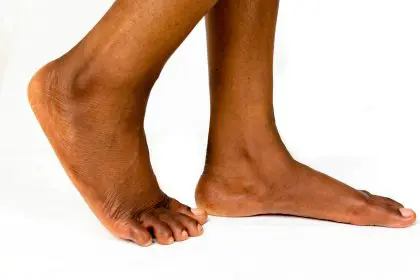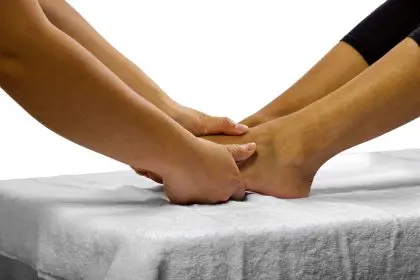From height predictions to personality assumptions, experts clarify what having bigger feet really means—and what it definitely doesn’t. Research dispels popular misconceptions about large feet, from height predictions to dating advantages, revealing the truth behind these persistent beliefs.
Having larger-than-average feet often comes with a barrage of assumptions and misconceptions. These persistent myths can range from amusing to frustrating for those who wear extended shoe sizes. While some of these beliefs have been around for generations, modern understanding reveals most have little basis in reality.
For the millions of people with larger feet, these unfounded beliefs can sometimes lead to unnecessary self-consciousness. Understanding the facts behind these myths helps everyone appreciate the natural diversity in human body proportions.
Height predictions and foot size correlations
Perhaps the most common belief about large feet suggests they automatically indicate tall stature. While there’s often some correlation between height and foot size, the relationship isn’t nearly as direct as many assume.
Foot size develops through a complex interplay of genetic factors, with some people naturally having proportionally larger or smaller feet regardless of their height. Many shorter individuals have surprisingly large feet, while some exceptionally tall people manage with relatively modest shoe sizes.
This misconception likely persists because taller people generally do require larger footwear to maintain balance. However, foot size alone makes for an unreliable height predictor, with countless exceptions disproving the supposed rule.
Coordination and movement abilities
The image of someone with large feet tripping over themselves has become a comedy staple, reinforcing the myth that bigger feet mean clumsier movements. This stereotype suggests navigating the world with larger appendages must inherently lead to awkwardness.
Reality tells a different story entirely. Coordination depends on neurological factors, practice, and body awareness—not foot dimensions. Many professional athletes with exceptionally large feet demonstrate remarkable agility, precision, and grace in their movements.
Swimmers, in particular, often benefit from larger feet that provide natural flipper-like propulsion in water. Far from being a hindrance, bigger feet can sometimes offer advantages in certain physical activities.
Anatomical correlations and dating myths
Perhaps the most persistent myth involves the supposed relationship between foot size and other physical attributes—particularly male anatomy. This notion has spawned countless jokes and knowing glances when someone mentions wearing a large shoe size.
Scientific research consistently finds no correlation between foot size and other body measurements. Foot dimensions develop independently from other physical traits, governed by specific genetic factors unrelated to those determining other aspects of anatomy.
This myth likely persists partly because it makes for easy humor, but its continued circulation does nothing but perpetuate unfounded stereotypes about body proportions.
Fashion and footwear availability
Many people with larger feet believe they’re doomed to limited style options—forced to choose from whatever happens to be available in extended sizes rather than what they’d actually prefer to wear.
While finding fashionable shoes in larger sizes presented genuine challenges in the past, today’s market offers unprecedented variety. Numerous mainstream brands now extend their size ranges, while specialty retailers cater specifically to those with larger feet.
Online shopping has revolutionized footwear access for everyone, particularly benefiting those with less common sizes. The days of settling for whatever basic styles happen to be available are largely over, with options now existing across virtually every price point and style category.
Personality traits and physical characteristics
Some persistent folklore suggests people with larger feet must have bigger, more outgoing personalities to match their physical proportions. This curious belief attempts to link physical characteristics with temperament and social tendencies.
Personality development emerges from complex interactions between genetics, environment, upbringing, and life experiences—with foot size playing absolutely no role in determining whether someone tends toward introversion or extroversion.
This myth exemplifies the human tendency to create patterns and connections even where none exist. While someone with large feet might happen to have an outgoing personality, the two characteristics remain entirely unrelated.
Movement speed and efficiency
Another curious misconception suggests people with bigger feet must move more slowly or awkwardly. This belief seemingly contradicts the equally common notion that longer legs (which often accompany larger feet) enable faster running speeds.
Walking and running efficiency depend on numerous biomechanical factors including stride length, muscle strength, cardiovascular fitness, and technique—not foot size. Many championship runners possess notably large feet that provide excellent stability and power transmission.
This myth particularly frustrates those with larger feet who pride themselves on their speed or agility, as it imposes limitations that have no basis in physiological reality.
Comfort and footwear fit challenges
The final common myth suggests people with bigger feet face inevitable discomfort and chronic fit problems. While finding proper-fitting shoes can indeed present challenges, the notion that larger feet automatically mean permanent footwear problems oversimplifies a complex issue.
Modern footwear design has evolved substantially, with many brands now offering multiple width options alongside extended length sizes. Custom orthotics and specialized fit systems further enhance comfort possibilities for feet of all dimensions.
The real challenge often involves finding retailers who maintain adequate stock in extended sizes, rather than inherent problems with larger feet themselves. With proper measurement and appropriate footwear selection, people with larger feet can experience excellent comfort and support.
Celebrity perspectives on larger feet
Many public figures with notably large feet have addressed these myths, bringing attention to the unnecessary stigma sometimes attached to foot size. Basketball players, swimmers, models, and actors with larger-than-average feet often discuss the amusing misconceptions they encounter.
These celebrities help normalize size diversity by openly discussing their own experiences finding appropriate footwear and dealing with common assumptions. Their visibility helps challenge stereotypes while providing representation for others with similar physical characteristics.
From red carpet appearances in stylish custom footwear to casual social media posts about shoe shopping challenges, these public discussions help dispel lingering myths while celebrating physical diversity.
The psychological impact of foot-size stereotypes
While most foot size myths seem relatively harmless, their cumulative effect can create needless self-consciousness. Teenagers experiencing growth spurts that affect their feet before the rest of their body may feel particularly vulnerable to teasing based on these misconceptions.
Body image experts note that focusing on any single physical characteristic as somehow determining other aspects of identity or capability can contribute to unnecessary anxiety. Recognizing and debunking these myths helps promote healthier attitudes toward natural body diversity.
For parents of children with larger feet, understanding these common misconceptions provides valuable talking points to help build confidence and resist potential teasing based on unfounded stereotypes.
Embracing foot diversity as natural variation
Human bodies display incredible diversity in all dimensions, with foot size representing just one aspect of our natural variation. Anthropologists note that foot proportions evolved differently across populations based on environmental factors, ancestral patterns, and other evolutionary influences.
Rather than attaching meaning or expectations to any particular foot size, modern understanding recognizes that the wide spectrum of human physical characteristics represents normal biological diversity. Neither smaller nor larger feet are inherently better—they’re simply different.
By recognizing these myths for what they are—unfounded assumptions with no scientific basis—we can appreciate the remarkable diversity of human bodies without unnecessary judgment or stereotyping.

















